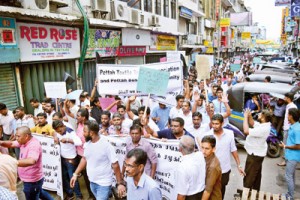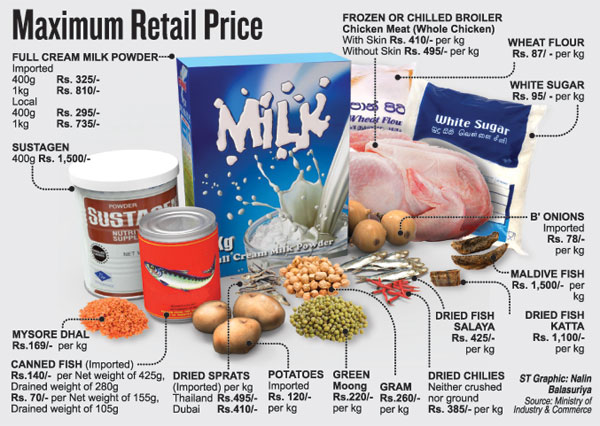News
VAT’s the matter
View(s):- Ad hoc policies add to confusion
- Lifting exemptions, wholesale, retail trade liable for VAT worsen situation
By Namini Wijedasa
In November last year, Finance Minister Ravi Karunanayake criticised the manner in which successive Governments had levied the Value Added Tax (VAT). The system was severely distorted due to “ad hoc polices adopted time to time”, he bemoaned, while presenting the 2016 Budget.

Pettah traders take to the streets on Friday
The Budget introduced revisions; new VAT rates were announced. But just five months later–well after the Budget was approved and passed in Parliament–the Government changed its mind, bringing in further ad hoc amendments to the VAT system. Confusion ensued.
The Budget did away with the single rate of 11% VAT. It introduced three bands: zero percent for goods export, provision of services outside Sri Lanka and for payments in foreign currency; eight percent for supply of manufactured and imported goods; and 12.5% for the services sector. The wholesale and retail trades were excluded. The Nation Building Tax (NBT) was also increased from two percent to four percent and certain exemptions removed.
The Inland Revenue Department issued a notice saying the amended rates were effective from January 1, 2016. However, the Government soon saw that the higher NBT was pushing up the price of goods and services more than the amended VAT rates were, a Finance Ministry official said.
This is because the NBT is a cascading tax, defined as “a turnover tax that is applied at every stage in the supply chain, without any deduction for the tax paid at earlier stages”. By contrast, the VAT is levied only on the amount by which the value of an article has been increased at each stage of its production or distribution.
“VAT is a good system,” reasoned A.K. Seneviratne, Director General of the Finance Ministry’s Department of Fiscal Policy. “It is not cascading and non-regressive. With turnover tax and NBT, the prices would have been more.”
There followed a fresh Finance Ministry directive in April 2016: Hike the VAT rate to a single band (again) of 15% and return the NBT to two percent with effect from May 2, 2016. But telecom services, private education and private healthcare sectors were now drawn into the VAT net. The wholesale and retail trades were no longer deemed exempt. And NBT exemptions granted to the telecom services and supply of electricity, among others, were lifted.
The administration also had other compulsions. On April 28, just a day before the Finance Ministry released its second revision to the VAT and NBT, the International Monetary Fund announced a staff-level agreement for a US$ 1.5 billion loan to Sri Lanka. In return, the IMF expected comprehensive reforms to the tax system, including the introduction of special rates to broaden the tax base. In short, to make more people pay more taxes.
 The Government was met with heavy opposition. With the revised rates applicable from May 2, hospital, telephone and private education bills rocketed. The increases were keenly felt by the public as VAT had not previously been charged in these sectors. The sick were particularly affected. Although pharmaceuticals had been excluded from VAT, the exemption did not pertain to in-patient bills. So anyone who received in-house treatment at a private hospital found the 15% VAT computed on the total bill. It was the same for diagnostic tests.
The Government was met with heavy opposition. With the revised rates applicable from May 2, hospital, telephone and private education bills rocketed. The increases were keenly felt by the public as VAT had not previously been charged in these sectors. The sick were particularly affected. Although pharmaceuticals had been excluded from VAT, the exemption did not pertain to in-patient bills. So anyone who received in-house treatment at a private hospital found the 15% VAT computed on the total bill. It was the same for diagnostic tests.
Meanwhile, traders around the country started protesting. They believed that goods will become too dear for the public to buy, and that they did not have the capacity to keep records. But a senior Finance Ministry official said it was also because the real earnings of these traders–particularly those in home industries and other small and medium sectors–would be recorded once they registered under the new VAT system. This could make them liable for income tax.
Under pressure, the Government has brought in additional VAT exemptions in June; in other words, more “ad hoc” changes. These included private medical testing, diagnosis and dialysis. Education services are also likely to be excluded. It is not know what other areas will be revisited. Any amendments the Cabinet approves in reply to populist demands will be introduced at the committee stage of the VAT (Amendment) Bill.
That is the next problem. It is not clear when the VAT (Amendment) Bill will come up in Parliament although it was belatedly listed in the Order Paper on July 8. The law should have been passed before the Government started collecting the revised taxes. Still, it is common for administrations to present retrospective tax bills. The previous regime repeatedly did the same.
The Constitution is clear. It says no tax, rate or any other levy shall be imposed by any local authority or any other public authority, “except by or under the authority of a law passed by Parliament or of any existing law”. “So it wasn’t that the procedure followed wasn’t illegal,” commented Naomal Goonewardena, a taxation specialist with the law firm Nithya Partners. “It was just never challenged.”
Even under this flawed practice, however, such amendments were usually through by the 31st of March of a particular year. But this time, the Bill was delayed by a full eight months after the Budget was approved and seven months since the revised VAT was first collected. Authoritative sources said that this was because some clauses had to be redrafted in order to reflect the policy decisions taken in April.
“The first VAT (Amendment) Bill encompassing the changes envisaged in the Budget was ready and with the Legal Draftsman,” these sources said. “Then the Government made new decisions in April which meant the Bill had to be redrawn.”
This second draft was not sent by the Finance Ministry to the Legal Draftsman as the situation was so fluid. And, in the interim, the Government just kept wavering.
“I think the main thing with the revenue proposals is that they must be definitive, we must be told exactly what they are, what the date of implementation is and the laws must be passed within the definable time period,” Mr. Goonewardena said. “This is still causing issues. They are not definitive, either with regard to what they will cover or the date on which they would be implemented.”
Ironically, with the entire debate centering on the VAT Bill, it has gone unnoticed that the revised NBT–complete with the new exemptions–was also being implemented without an amendment to the relevant law. There is still no Bill in sight.

